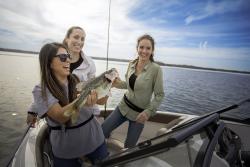Blog


Imagine you go to a store to buy gardening supplies for Spring planting. But while there, you find out none of the gloves are your size. When you ask a question about shrubs, the sales associate questions your interest in gardening and speaks mainly to your spouse, assuming he or she is the true gardener. After such a frustrating experience, you may feel discouraged about pursuing your hobby altogether, right?
Now replace gardening with fishing.
Unfortunately, this is how many women experience shopping for tackle and gear at retail stores.
In 2021, women accounted for 37 percent, or more than one-third, of those who fish—the highest percentage on record, according to the Special Report on Fishing. Yet, when you visit any fishing store, you’d probably think that women are just a sliver of the sport.
The rise in interest in fishing among women presents an ocean of opportunity for the industry. Bringing more women into fishing can help diversify the sport and keep it relevant in today’s fast-paced world. More women fishing can also lead to more male and youth fishing participants.
According to the Pew Research Center, women make most household decisions around activity planning and family spending. More importantly, Nielsen says women control or influence 85 percent of all consumer spending, buying cars, tickets to sporting events, and, yes, even fishing gear.
Yet, for females who fish or are interested in trying it out, real barriers make retention difficult. According to recent research from the Recreational Boating & Fishing Foundation (RBFF) and global research firm Ipsos, female anglers face resistance, disrespect and under-representation across the fishing community and industry.
Some of these challenges start with apparel and gear. For example, 80 percent of active female anglers do not feel gear or apparel is designed with women in mind; the percentage is even higher among lapsed anglers who left the sport.
One female angler recalls, “I really had a hard time finding waders that fit due the fact I am a woman and short. The stores are set up for men. In fact, I have been asked ‘are you buying that for your husband?”
Buying fishing gear is equally challenging. Only 43 percent of active female anglers have been satisfied with recent shopping trips. One-third of women described negative experiences related to store employees. They recounted stories of needing to be taken more seriously as anglers or being dismissed entirely for their interest.
One woman said, “The salesman kept speaking to my husband, even though he knew that I was the one whom the purchase was for. He would ask a question, look at my husband, and I would answer.”
While these insights are discouraging, they can serve as examples of how the industry can develop a better female mindset and ultimately retain more women in the sport while keeping the health of their business. The industry can provide a more welcoming retail experience for women. Consider these recommendations:
- Create an inclusive range of products: Women are interested in apparel and gear that is adjustable in size and in a variety of neutral color options (pink is not the only gear color that women seek).
- Consider diversifying staff: Women, specifically women of color, feel more accepted and willing to ask questions and make purchases when they can talk to others like them. In fact, in RBFF’s study, 45 percent of non-white female anglers say hiring more female employees would improve their experience.
- Encourage an inclusive sales approach: When a potential angler walks in the door, sales associates are the first line to welcoming that individual. In RBFF’s study, nearly half of the women said encouraging employees to treat them with greater respect and speaking to them without judgment would improve their shopping experience.
To capitalize on the growth potential of the female audience, it’s time for the industry to meet this moment. Together, we can welcome more women to the water! Dive into RBFF’s research, Underneath the Wave of Women Fishing, and get started welcoming more women to fishing and boating today.



